Evaluations
10oct10\begin{document}
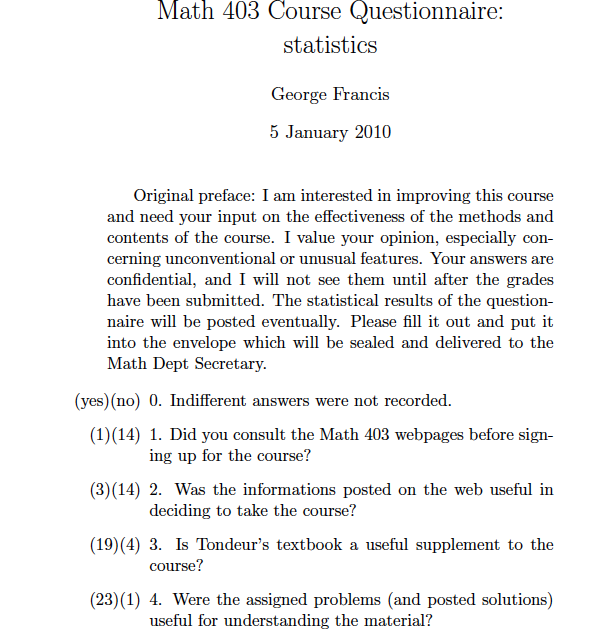 \section{Introduction}
For the \textit{netGeometry} experiment a number of student self-evaluations,
and student evaluations of the various course innovations were conducted. Some
of these were more instructive than others, and all will be reported on here
eventually. For the present we discuss only two such instruments, (1) the
tests for prerequisites the
extramural students did/did not have, and (2) the 33-35 question-long
anonymous student evaluations of the blended courses.
In addition, a faculty member of the Department of Curriculum and
Development visited sessions of the blended MA403FA09 weekly.
Here is the letter by Prof. Gloriana Gonzalez .
\section{Evaluation of Student Prerequisites}
\subsection{Self-evaluation}
\section{Introduction}
For the \textit{netGeometry} experiment a number of student self-evaluations,
and student evaluations of the various course innovations were conducted. Some
of these were more instructive than others, and all will be reported on here
eventually. For the present we discuss only two such instruments, (1) the
tests for prerequisites the
extramural students did/did not have, and (2) the 33-35 question-long
anonymous student evaluations of the blended courses.
In addition, a faculty member of the Department of Curriculum and
Development visited sessions of the blended MA403FA09 weekly.
Here is the letter by Prof. Gloriana Gonzalez .
\section{Evaluation of Student Prerequisites}
\subsection{Self-evaluation}
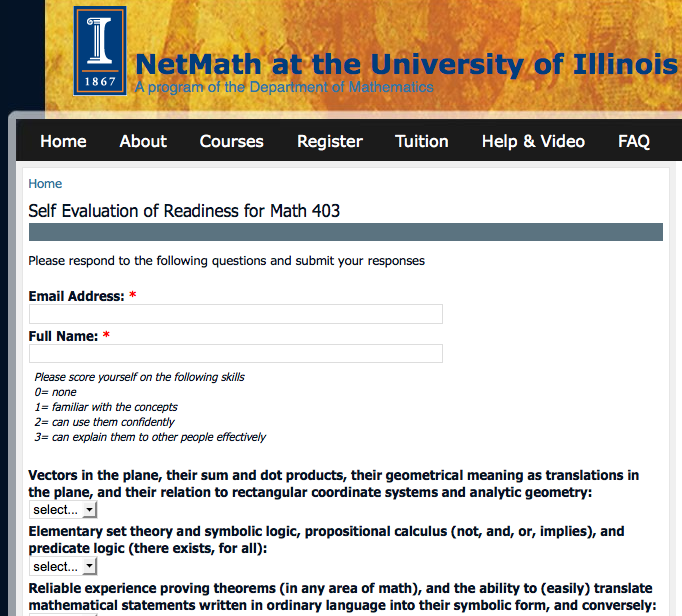 By the third time our extramural online course was offered it had become abundantly clear that some screening of the prospective student's prerequisites was
necessary to prevent subsequent misunderstandings. No amount of personal email correspondence and web posting of requirements seemed to suffice.
The first such
self-test consisted of three questions on the
mathematical prerequisites, and 3 on networking skills. The student gave
themselves one of 5 ratings:
\begin{itemize}
\item 0 = none \\
\item 1= familiar with the concepts \\
\item 2= can use them confidently \\
\item 3= can explain them to other people effectively \\
\begin{itemize}
This
Self Evaluation of Readiness for Math 403 data
were collected from a \textit{Captcha} protected Netmath website.
[Added 2jan14: This link was deprecated. The sense of this self-evaluation
survey can be extracted from the following summary originally submitted.]
\subsection{Objective versus subjective evaluation}
By the third time our extramural online course was offered it had become abundantly clear that some screening of the prospective student's prerequisites was
necessary to prevent subsequent misunderstandings. No amount of personal email correspondence and web posting of requirements seemed to suffice.
The first such
self-test consisted of three questions on the
mathematical prerequisites, and 3 on networking skills. The student gave
themselves one of 5 ratings:
\begin{itemize}
\item 0 = none \\
\item 1= familiar with the concepts \\
\item 2= can use them confidently \\
\item 3= can explain them to other people effectively \\
\begin{itemize}
This
Self Evaluation of Readiness for Math 403 data
were collected from a \textit{Captcha} protected Netmath website.
[Added 2jan14: This link was deprecated. The sense of this self-evaluation
survey can be extracted from the following summary originally submitted.]
\subsection{Objective versus subjective evaluation}
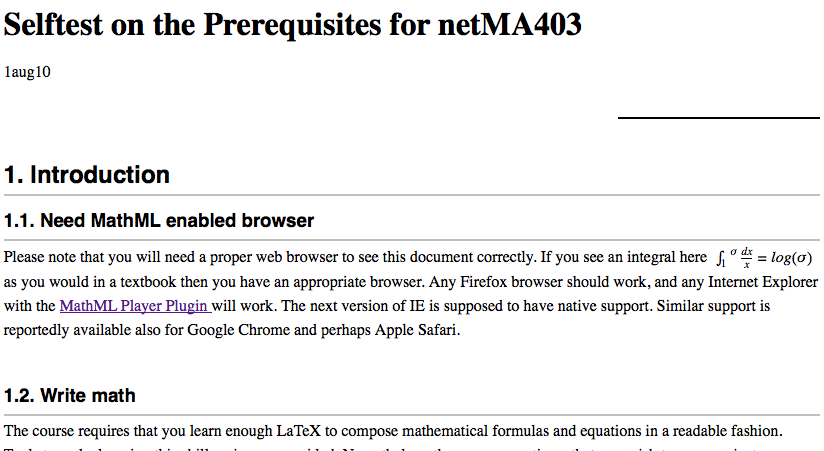 The self-evaluation system described above has worked for years with
prospective students of my \textit{Campus Honors Program} freshman seminar,
but it failed with the netGeometry students. Their overly optimistic
opinions of their readiness for the course were not confirmed by their
subsequent performance in the course. Therefore, we modified a lesson on
prerequisites by adding confidential (Apache access controlled) questions
the students reading the lesson answered, and received personal responses.
A secondary reason for using an actual lesson from this is to check the
student's browser for the ability to display \textit{MathML}, as this will
be needed for all subsequent lessons.
Here are the screenshots of what a student who has answered the questions
embedded in the text would see
\begin{itemize}
\item Introduction
\item Why the quiz
\item Notation
\item Coordinates
\item Vectors
\item Lines
\item Retest first question
\end{itemize}
While we now have a reliable means of determining prerequisite knowledge
in exramural students we know of no way of pre-testing whether the prospective
student has the resources in time and energy to put the requisite work into
the course.
\Section{Confidential anonymous questionnaires.}
The self-evaluation system described above has worked for years with
prospective students of my \textit{Campus Honors Program} freshman seminar,
but it failed with the netGeometry students. Their overly optimistic
opinions of their readiness for the course were not confirmed by their
subsequent performance in the course. Therefore, we modified a lesson on
prerequisites by adding confidential (Apache access controlled) questions
the students reading the lesson answered, and received personal responses.
A secondary reason for using an actual lesson from this is to check the
student's browser for the ability to display \textit{MathML}, as this will
be needed for all subsequent lessons.
Here are the screenshots of what a student who has answered the questions
embedded in the text would see
\begin{itemize}
\item Introduction
\item Why the quiz
\item Notation
\item Coordinates
\item Vectors
\item Lines
\item Retest first question
\end{itemize}
While we now have a reliable means of determining prerequisite knowledge
in exramural students we know of no way of pre-testing whether the prospective
student has the resources in time and energy to put the requisite work into
the course.
\Section{Confidential anonymous questionnaires.}
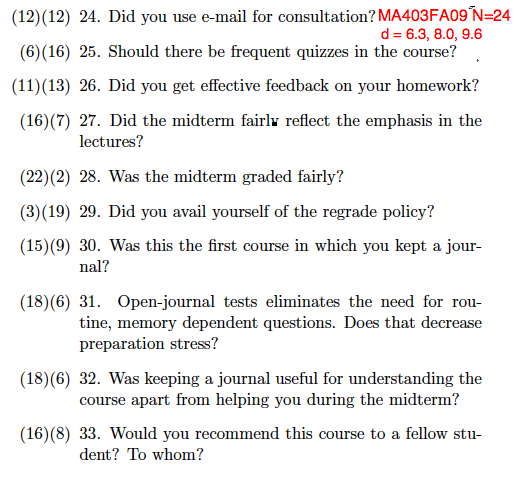
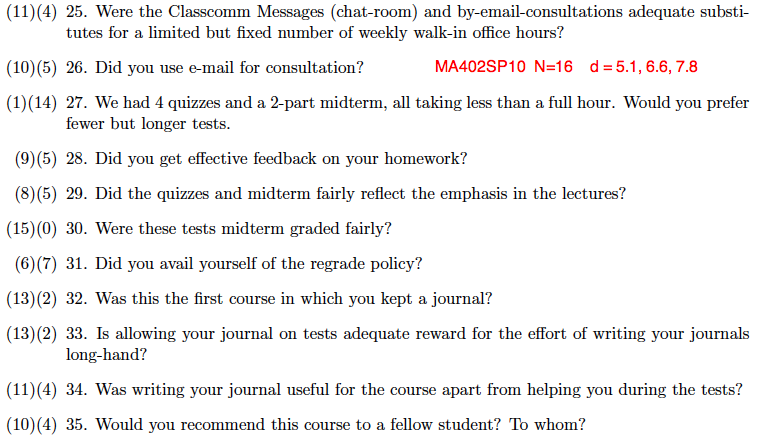 I have been using an anonymous (30 plus questions) course evaluation form
with students in my courses for the past 15 years. It is adapted to
the particular course and the statistical results are posted on the
web for future students to read.
The students fill it out in the last week of
the course, it is deposited with a secretary, who holds the forms until
after I submit the grades. The answers to this questionnaire for the
netGeometry courses are here
Answers MA403FA09
and
Answers MA402FA09 .
[Added 2jan14: The above links were deprecated persuant to FERPA rules. Copies may be
obtained privately.]
\end{document}
I have been using an anonymous (30 plus questions) course evaluation form
with students in my courses for the past 15 years. It is adapted to
the particular course and the statistical results are posted on the
web for future students to read.
The students fill it out in the last week of
the course, it is deposited with a secretary, who holds the forms until
after I submit the grades. The answers to this questionnaire for the
netGeometry courses are here
Answers MA403FA09
and
Answers MA402FA09 .
[Added 2jan14: The above links were deprecated persuant to FERPA rules. Copies may be
obtained privately.]
\end{document}